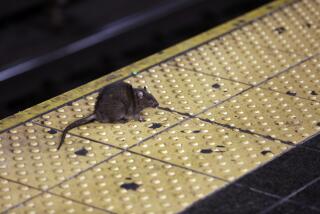Vietnamese Learn Why Cats Should Not Be Kept Away
- Share via
THANH XUAN, Vietnam — An army of rats is nibbling its way through Vietnam’s precious rice fields, but the day has been saved by mobilizing the citizenry with a new battle cry: “Kill Rat. Grow Cat.”
Just two months into the campaign, the body count already stands at 27 million rats. They have been smoked and flooded out of their holes, chased down and clubbed to death and poisoned. The proof of each kill is a severed tail.
Just as Americans used to collect green stamps, farmers throughout the country are keeping the tails in plastic bags until they have enough to warrant a trip to the local rat patrol center. Their reward for each tail turned in is 200 dong, or about 2 cents.
In thousands of villages, such as Thanh Xuan on the northern outskirts of Hanoi, farmers bicycle over dirt roads with their sacks of tails to claim their reward and accept congratulations from government officials. One man lugging a bag of 2,000 tails cycled away with more money than he normally earns in an entire month.
“This is easy work,” he said. “There are rats everywhere.”
With some regions producing three rice crops annually and the country having enjoyed bumper harvests three years running, rats have found Vietnam to be a veritable banquet, and their population has soared. But there’s another reason why their numbers are so huge: Vietnam has eaten most of its cats.
Many Vietnamese have an appetite for such natural rat-catchers as cats, dogs and snakes. And when the rat crisis hit, government officials who visited various villages to discuss a plan of attack were stunned to find that as often as not there wasn’t a cat in sight.
Prime Minister Phan Van Khai reacted quickly. He ordered the closure of “little tiger” restaurants that specialize in cat in Haiphong and the snake restaurants in Hanoi’s Le Mat neighborhood. Also on the hit list were the restaurants in the Nhat Tan area in the capital featuring dog entrees.
Additionally, Khai said he was ending the lucrative business of exporting dogs and cats to China, where house pets are also a delicacy.
Several zoos joined in the campaign, announcing that they were releasing their snakes into the rice fields. Some were poisonous, causing concern among farmers--but there were no complaints about freeing pythons, which no one eats anyway because they are believed to cause impotence.
“I know growing cats may seem a long-term solution to the rat problem,” said Thanh Xuan’s agricultural expert, Nguyen Van Tien. “They take a long time to grow up, they don’t have many children, and they can run away or die from disease. But they don’t like rats, so it’s an important option.”
The government says rats destroyed 925,000 acres of rice paddies last year. So far, the rodents have devoured 320,000 acres of this year’s winter-spring crop, and authorities say they fear that the eventual damage could cost Vietnam $30 million.
The problem has been worsened by farmers’ use of quick-kill poisons, which kill nearly as many chickens, dogs and cats as they do rats. To counter this, Vietnam has introduced a “bio-rat” poison that is safe for other animals. But rats that eat it can still stagger around for days before dying, and the poison has not proved popular.
More to Read
Sign up for Essential California
The most important California stories and recommendations in your inbox every morning.
You may occasionally receive promotional content from the Los Angeles Times.













